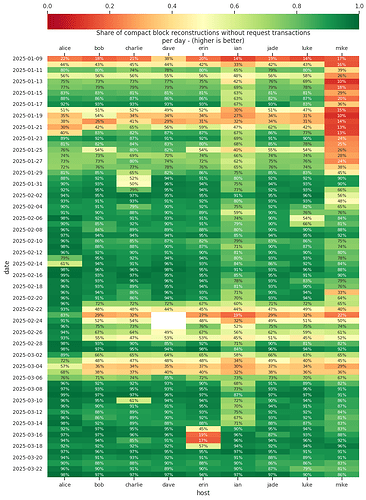- I’ve changed node
aliceto run withblockreconstructionextratxn=10000early February. This had a noticeable effect the following days with slightly higher scores starting 2025-02-06. During the increased mempool activity between 2025-02-21 and 2025-03-06 it performed significantly better than my other nodes. - Node
charlieand nodeerinwere switched to a branch that includes p2p: track and use all potential peers for orphan resolution #31397 at the same time in early February. I don’t see any immediate improvement for these two nodes. - Node
ianwas running Bitcoin Corev26.1until I switched all nodes to runv29.0rc1release candidate.ianclearly performed worse than the other nodes before the update, which is expected as e.g.mempoolfullrbfwasn’t default inv26.1. - Node
mikedoesn’t allow inbound connections (while the other nodes do and usually have full inbound slots). This is noticeable in the reconstruction performance. Only having eight peers that informmikeabout transactions is probably likely worse than having close to 100 peers that inform you about new transactions.
The stats from alice, charlie, and erin could indicate that orphans aren’t the problem, but conflicts, replacements, and policy invalid transactions (i.e. extra pool txns) cause low performance during high mempool activity. Although, I’m not sure if these three moths of data are enough to be certain yet.
I’ve started to look at the data I’ve been recording. It seems that many of my peers I announced a compact block to end up requesting very different sets of transactions (and usually larger sets) than I request from my peers. I assume many of them might be non-listening nodes like mike or run with a non-default configuration. This needs more work, but I hope to post more stats on requested transactions here at some point.
I’ve also noticed that my listening nodes running with the default configuration often independently request similar sets of transactions. This seems promising in regards to predictably prefilling transactions in our compact block announcements. My assumption would be that if we prefill:
- transactions we had to request
- transactions we took from our extra pool
- and prefilled transactions we didn’t have in our mempool (i.e. prefilled txns that were announced to use and ended up being useful)
we can improve the propagation time among nodes that accept inbound connections and use a “Bitcoin Core” default policy. This in turn should improve block propagation time of the complete network as now more nodes know about the block earlier. Additionally, useful prefilled transactions don’t end up wasting bandwidth, only transactions that a peer already knew about would waste bandwidth. These improvements would probably be most noticeable during high mempool activity: the (main) goal wouldn’t be to bring the days with 93% (of reconstructions not needing to request a transaction) to 98% but rather the days with 45% to something like 90% for well-connected nodes.
Since Bitcoin Core only high-bandwidth/fast announces compact blocks to peers that specifically requested it from us (because we quickly gave them new blocks in the past), non-listening nodes that are badly connected won’t start sending wasteful announcements with many prefilled, well-known transactions to their peers.
I’ve started implementing this in 2025-03-prefill-compactblocks but its still work-in-progress:
- limit the prefill amount to something like 10kB worth of transactions as per BIP152 implementation note #5. I think this is useful to avoid wasting too much bandwidth if a node does a high-bandwidth announcement but, for some reason, prefills a lot of well-known transactions in the announcement
cmpctblockdebug logging on wasted bandwidth: log the number of bytes of transactions we already knew about when receiving a prefilled compact block. This can be tracked/monitored to determine if were wasting too much bandwidth by prefilling- since the positive effect on the network is only measurable with a wide(r) deployment of the prefilling patch, it’s probably worthwhile to do some Warnet simulations on this and test the improvement under different scenarios.
